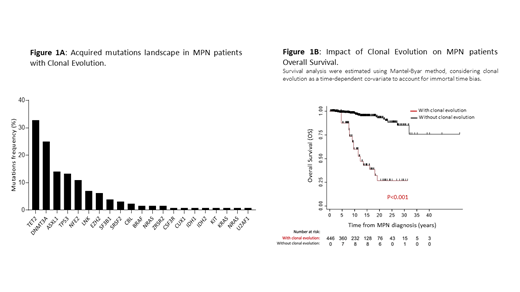Abstract

Introduction:
Although myeloproliferative neoplasms (MPN) are driven by three mutually exclusive driver mutations (JAK2, CALR and MPL), targeted deep sequencing studies identified multiple additional somatic mutations potentially impacting MPN evolution. Presence of a high molecular risk (HMR: ASXL1, EZH2, SRSF2 and IDH1/2) or a TP53 mutations has been associated with adverse prognosis. However, to date, the effect of clonal evolution (CEv) on MPN patients' outcome has not been evaluated, as most of the studies assessed mutational-based prognosis stratification from single baseline molecular genotyping. The objective of our study was to describe the clinical and molecular characteristics of patients with CEv in a large cohort of MPN patients and analyze its impact on patients' outcome.
Methods:
A total of 1538 consecutive patients were diagnosed with MPN according to WHO criteria and followed in our hospital between January 2011 and January 2021. From this large retrospective cohort, we included in this study 446 patients who had at least 2 molecular analyses during the chronic phase of MPN, performed at diagnosis and/or during follow-up using next generation sequencing (NGS), targeting a panel of 36 genes involved in myeloid malignancies. Significant variants were retained with a sensitivity of 1%. CEv was defined as the acquisition of a new additional non-driver mutation between baseline and subsequent NGS evaluation. Statistical analyses were performed using the STATA software (STATA 17.0 for Mac Corporation, College Station, TX).
Results:
The median age at MPN diagnosis in our whole cohort was 51 years [IQR 41 - 60]. Our cohort included 167 (37%), 205 (46%) and 64 (14%) patients with polycythemia vera, essential thrombocythemia and primary myelofibrosis (MF) respectively.
With a median interval of 1.6 years [IQR 1.0 - 2.8] between the first and the second NGS analysis in the whole cohort, CEv occurred in 128 patients (29%). Patients with CEv were significantly older compared to patients without CEv (n=318) (p=0.03). MPN diagnosis, the type of driver mutation and complete blood counts at MPN diagnosis did not differ between the 2 groups. Eighty-one (63%) and 198 (62%) patients with or without CEv respectively had at least one additional non-driver mutation at baseline NGS (p=0.59), while the rate of HMR (n=25 (20%) versus n=79 (25%)) or TP53 (n=7 (5%) versus n=20 (6%)) mutations at baseline NGS did not differ between the 2 groups.
Thirty six out of 128 (28%) of patients with CEv had more than 1 acquired mutation. Most recurrently acquired mutations involved the epigenetic regulators TET2 and DNMT3A that were mutated in respectively 33% and 25% of patients with CEv (Figure 1A). Moreover, 38% of CEv patients acquired HMR (ASXL1 (14%), EZH2 (6%), SRSF2 (3%), IDH1/2 (2%)) or TP53 (13%) mutations. After a median follow up of 10.8 years [IQR 6.6 - 17.2] in the whole cohort representing a total of 5635 patient years, 32 (7%) patients died, and 11 (2.5%) and 11 (2.5%) patients with at least 2 NGS performed during MPN chronic phase transformed respectively into secondary MF or myelodysplastic syndrome / acute myeloid leukemia (MDS/AML). Interestingly, CEv (HR 11.27, 95%CI [5.09; 24.96], p<0.001) (Figure 1B), age at MPN diagnosis (HR 1.11, 95%CI [1.07; 1.15], p<0.001) and the presence of HMR mutations at baseline NGS (HR 4.48, 95%CI [2.05; 9.77], p <0.001) independently adversely impacted OS in a COX regression multivariate analysis. CEv also independently adversely impacted MDS/AML free survival (HR 13.15, 95%CI [3.88; 44.47], p<0.001) and secondary MF free survival (HR 21.13, 95%CI [6.18; 72.20], p<0.001) in a COX regression multivariate analysis.
Conclusion:
Our study on a large retrospective clinically and biologically annotated real-life cohort of MPN patients with long-term follow up shows that CEv independently adversely impacts OS, MDS/AML and secondary MF free survivals. CEv occurred in a clinically relevant proportion of MPN patients (28%) and was associated with patients' age. Acquired mutations mainly involved epigenetic regulators, HMR and TP53 genes. These results suggest that serial molecular monitoring using NGS could be routinely implemented in MPN patients follow up, to assess more accurately disease evolution and potentially update therapeutic management.
Raffoux: PFIZER: Consultancy; CELGENE/BMS: Consultancy; ABBVIE: Consultancy; ASTELLAS: Consultancy. Kiladjian: Novartis: Membership on an entity's Board of Directors or advisory committees; Taiho Oncology, Inc.: Research Funding; Bristol Myers Squibb: Membership on an entity's Board of Directors or advisory committees; Incyte Corporation: Membership on an entity's Board of Directors or advisory committees; PharmaEssentia: Other: Personal fees; AOP Orphan: Membership on an entity's Board of Directors or advisory committees; AbbVie: Membership on an entity's Board of Directors or advisory committees. Benajiba: Gilead: Research Funding; Pfizer: Research Funding.
Author notes
 This icon denotes a clinically relevant abstract
This icon denotes a clinically relevant abstract


This feature is available to Subscribers Only
Sign In or Create an Account Close Modal